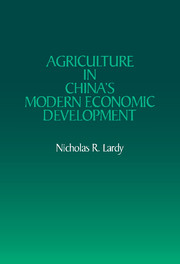Book contents
- Frontmatter
- Contents
- List of tables, figures, and maps
- Preface
- Map 1 The provinces of the People's Republic of China
- 1 The role of agriculture
- 2 Planning and allocative efficiency
- 3 Prices and intersectoral resource transfers
- 4 Living standards and the distribution of income
- 5 Prospects for reform
- Appendixes
- Notes
- References
- Index
2 - Planning and allocative efficiency
Published online by Cambridge University Press: 16 September 2009
- Frontmatter
- Contents
- List of tables, figures, and maps
- Preface
- Map 1 The provinces of the People's Republic of China
- 1 The role of agriculture
- 2 Planning and allocative efficiency
- 3 Prices and intersectoral resource transfers
- 4 Living standards and the distribution of income
- 5 Prospects for reform
- Appendixes
- Notes
- References
- Index
Summary
The purpose of this chapter is to evaluate how the evolution of farm institutions and the system of agricultural planning affected the growth of output and productivity in agriculture since the Chinese Communist Party rose to power in 1949. Most analyses assume that, with the obvious exception of the late 1950s when producing and accounting units were so large that the connection between individual effort and reward was tenuous, production units allocate resources efficiently, much as might occur with profit-maximizing behavior by farm households in a market economy. The agricultural sector is presumed to produce the maximum potential output given the prices set by the state for farm products and for current inputs, the constraint imposed by available supply of land, and farmers' labor—leisure preference. The size of collective units and the methods for selecting team leaders and for distributing collective income all have been thought to facilitate efficient resource allocation (Parish and Whyte 1978, 117; Perkins 1975a, 350; Thomas Rawski 1979, 140).
These analyses, however, have focused on the internal organization of collective agriculture and virtually have ignored the larger institutional setting in which collective farm units operate. Most critically, they have not considered either the constraints imposed by the planning system on farmlevel production decisions or the nature of the markets in which farm units sell their output and purchase both consumption goods and farming inputs.
- Type
- Chapter
- Information
- Agriculture in China's Modern Economic Development , pp. 18 - 97Publisher: Cambridge University PressPrint publication year: 1983



